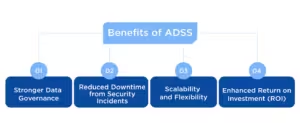The evolution of database security has taken a major leap forward with the expansion of Advanced Database Security (ADS) into the Advanced Database Security Suite (ADSS). This transition represents a pivotal moment for organizations striving to protect sensitive data in an increasingly complex threat landscape. ADSS offers a more comprehensive approach, combining advanced technology, practical tools, and a holistic framework to safeguard critical database environments.
What Is Advanced Database Security (ADS)?
Advanced Database Security (ADS) refers to a sophisticated set of tools and methodologies designed to identify, monitor, and mitigate threats to databases. As a solution, ADS emphasizes protecting sensitive information from unauthorized access, malicious activities, and potential vulnerabilities. The system incorporates real-time monitoring, user activity analysis, and automated threat detection to ensure maximum protection.
ADS has been instrumental in mitigating database risks, but the demand for a more expansive, integrated solution led to its transformation into the Advanced Database Security Suite (ADSS).
Why Expand ADS Into ADSS?
The primary driver for this transformation is the growing complexity of cyber threats targeting database systems. Modern organizations deal with diverse data sources, cloud migrations, and dynamic workloads. As these challenges multiply, a single-layered security approach like ADS, while effective, is no longer sufficient.
ADSS broadens the capabilities of ADS by:
-
Enhancing Coverage Across Multiple Platforms
ADSS integrates seamlessly with cloud environments, on-premises systems, and hybrid infrastructures, ensuring no database is left vulnerable.
-
Advanced Threat Intelligence
By leveraging machine learning and AI, ADSS provides predictive analytics to anticipate and neutralize risks before they materialize.
-
Comprehensive Suite Features
Unlike the focused tools in ADS, the suite includes additional components like data masking, privilege management, and vulnerability assessments, delivering end-to-end protection.
Key Features of the Advanced Database Security Suite (ADSS)
ADSS builds upon the foundation of Advanced Database Security (ADS) by adding several new layers of defense. Here are the standout features:
-
User Behavior Analytics (UBA)
UBA tracks user interactions with databases, identifying unusual patterns such as unauthorized data access or suspicious queries. This proactive measure helps in preventing insider threats and external breaches.
-
Data Masking and Encryption
To ensure sensitive information remains protected, ADSS includes data masking for non-production environments and robust encryption for data-at-rest and in-transit.
-
Automated Compliance Monitoring
Adherence to data protection laws like GDPR, HIPAA, and PCI-DSS is made easier with ADSS. Automated compliance checks ensure that databases remain audit ready.
-
Dynamic Threat Protection
With real-time threat intelligence, ADSS continuously scans for vulnerabilities and mitigates risks using adaptive security protocols.
-
Cloud-Ready Security Tools
As cloud adoption grows, ADSS provides specialized security features for cloud-native databases like Amazon RDS, Microsoft Azure SQL, and Google Cloud Spanner.
Benefits of ADSS for Modern Organizations
The expansion into ADSS equips organizations with a powerful toolkit to address today’s cybersecurity challenges. Key advantages include:

-
Stronger Data Governance
ADSS empowers businesses to monitor data access and usage more effectively, ensuring that sensitive information is handled responsibly.
-
Reduced Downtime from Security Incidents
Faster threat detection and resolution reduce the risk of prolonged downtime, preserving operational efficiency.
-
Scalability and Flexibility
Whether managing a small database or a sprawling enterprise environment, ADSS scales to meet evolving security demands.
-
Enhanced Return on Investment (ROI)
With its comprehensive features, ADSS eliminates the need for multiple fragmented tools, reducing overall costs while delivering superior protection.
Implementing ADSS: A Strategic Move
Transitioning to the Advanced Database Security Suite (ADSS) is not just an upgrade; it is a strategic investment in the future of database protection. Organizations looking to make the shift should begin by evaluating their current database security measures. Conducting a risk assessment will help identify gaps that ADSS can address effectively.
To ensure a smooth implementation, organizations should:
- Partner with experts who understand both legacy ADS systems and the expanded suite.
- Train database administrators and IT teams to leverage the suite’s features effectively.
- To keep ahead of changing threats, update threat intelligence feeds frequently.
Conclusion
The expansion of Advanced Database Security (ADS) into the Advanced Database Security Suite (ADSS) marks a significant advancement in protecting sensitive data against modern threats. By adopting ADSS, organizations gain a comprehensive solution that combines robust features, seamless scalability, and proactive threat management. This move is essential for businesses striving to maintain trust, regulatory compliance, and data integrity in today’s digital-first world.
For organizations seeking to future-proof their database security strategy, the shift to ADSS is more than a necessity—it’s an opportunity to lead in data protection.
Read More:
Understanding the Virtual Private Cloud: A Modern Approach to Cloud Computing
A Comprehensive Guide to Choosing the Right CMS for Enhanced Security and Performance

